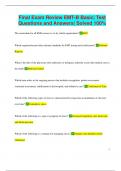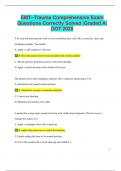⭐INQUIRE AND ACQUIRE⭐ LOOKING FOR BETTER GRADES? YOU ARE IN THE RIGHT PLACE!✅
An online platform containing verified documents of Question & Answers , 100% verified and approved by qualified personnel from Harvard University and University of New York, Guaranteed A+ score.
Information obtained from trained tutors and experienced collogue professors.
⚡OFFERS⚡
-Buy 2 bundles and get 1 free
-Buy 3 documents and get 1 free
NOW AVAILABLE; Request a desired document via stuvia message and receive it in 4 hours time
- 3350
- 0
- 365
Community
- Seguidores
- Siguiendo
18 Comentarios recibidos
3718 artículos

Retake Certification Exam: EMS Questions| CH. 5,7,8,10| Latest Update 2025
Retake Certification Exam: EMS Questions| CH. 5,7,8,10| Latest Update 2025 You respond to a patient experiencing shortness of breath and wheezing. They state they used their rescue inhaler but are not feeling better. What is your next step? Administer supplemental oxygen, reassess lung sounds, and prepare for advanced airway interventions if necessary. A patient presents with chest pain radiating to the jaw and left arm. What is your priority intervention in the prehospital settin...
- Examen
- • 13 páginas •
Retake Certification Exam: EMS Questions| CH. 5,7,8,10| Latest Update 2025 You respond to a patient experiencing shortness of breath and wheezing. They state they used their rescue inhaler but are not feeling better. What is your next step? Administer supplemental oxygen, reassess lung sounds, and prepare for advanced airway interventions if necessary. A patient presents with chest pain radiating to the jaw and left arm. What is your priority intervention in the prehospital settin...

NREMT Finals Exam- EMS Operations| Questions and Verified Answers| Correct 100%
NREMT Finals Exam- EMS Operations| Questions and Verified Answers| Correct 100% You arrive at the scene of an accident, and a patient refuses care despite a visible fracture. The patient is alert and oriented. How should you proceed? Explain the risks of refusing care, ensure they understand, document their refusal, and have them sign a refusal form. A patient becomes verbally aggressive during your assessment. What communication strategy should you use to de-escalate the situation...
- Examen
- • 19 páginas •
NREMT Finals Exam- EMS Operations| Questions and Verified Answers| Correct 100% You arrive at the scene of an accident, and a patient refuses care despite a visible fracture. The patient is alert and oriented. How should you proceed? Explain the risks of refusing care, ensure they understand, document their refusal, and have them sign a refusal form. A patient becomes verbally aggressive during your assessment. What communication strategy should you use to de-escalate the situation...

North Carolina EMT basic drug cards| Exam Q&A| Action, Primary Indication, Dose, Side Effects| Tested 2025 Fall
North Carolina EMT basic drug cards| Exam Q&A| Action, Primary Indication, Dose, Side Effects| Tested 2025 Fall **Aspirin** What is the mechanism of action for aspirin? Inhibits platelet aggregation by blocking the enzyme cyclooxygenase, reducing thromboxane production. What is the typical dose of aspirin for chest pain? 160-325 mg, chewed and swallowed. What is the primary indication for administering aspirin? Chest pain, suspected acute myocardial infarction (MI). What are ...
- Examen
- • 20 páginas •
North Carolina EMT basic drug cards| Exam Q&A| Action, Primary Indication, Dose, Side Effects| Tested 2025 Fall **Aspirin** What is the mechanism of action for aspirin? Inhibits platelet aggregation by blocking the enzyme cyclooxygenase, reducing thromboxane production. What is the typical dose of aspirin for chest pain? 160-325 mg, chewed and swallowed. What is the primary indication for administering aspirin? Chest pain, suspected acute myocardial infarction (MI). What are ...

Latest Update| EMT Basic Practice Exam 1| Reviewed Q&A| Solved 100%
Latest Update| EMT Basic Practice Exam 1| Reviewed Q&A| Solved 100% What type of respirators should EMTs wear when in contact with patients diagnosed with tuberculosis (TB)? High-efficiency particulate air (HEPA) respirators. Which of the following conditions requires the use of HEPA respirators for EMTs? Tuberculosis (TB). In which of the following scenarios is a HEPA respirator not required for EMTs? When caring for a patient with HIV/AIDS. When responding to a call involving ...
- Examen
- • 65 páginas •
Latest Update| EMT Basic Practice Exam 1| Reviewed Q&A| Solved 100% What type of respirators should EMTs wear when in contact with patients diagnosed with tuberculosis (TB)? High-efficiency particulate air (HEPA) respirators. Which of the following conditions requires the use of HEPA respirators for EMTs? Tuberculosis (TB). In which of the following scenarios is a HEPA respirator not required for EMTs? When caring for a patient with HIV/AIDS. When responding to a call involving ...

Jurisprudence EMS| Exam 2025/2026| Test Questions and Answers| Solved
Jurisprudence EMS| Exam 2025/2026| Test Questions and Answers| Solved What is the purpose of a jurisprudence exam for EMS professionals? To ensure understanding of state laws, regulations, and ethical responsibilities. What does "scope of practice" refer to in EMS? The procedures and actions a provider is legally permitted to perform. What should you do if a patient refuses treatment or transport? Obtain a signed refusal form and document the refusal thoroughly. What is t...
- Examen
- • 16 páginas •
Jurisprudence EMS| Exam 2025/2026| Test Questions and Answers| Solved What is the purpose of a jurisprudence exam for EMS professionals? To ensure understanding of state laws, regulations, and ethical responsibilities. What does "scope of practice" refer to in EMS? The procedures and actions a provider is legally permitted to perform. What should you do if a patient refuses treatment or transport? Obtain a signed refusal form and document the refusal thoroughly. What is t...

FINALS EXAM | EMT Test Prep Quizzes and Solutions| [Multiple Choice] Graded A
FINALS EXAM | EMT Test Prep Quizzes and Solutions| [Multiple Choice] Graded A What is the primary goal of the primary assessment in emergency medical care? A. To identify and treat life-threatening conditions B. To gather detailed patient history C. To perform a secondary assessment D. To administer medications A. To identify and treat life-threatening conditions What is the most appropriate action when responding to a suspected stroke patient? A. Initiate rapid transport and...
- Examen
- • 34 páginas •
FINALS EXAM | EMT Test Prep Quizzes and Solutions| [Multiple Choice] Graded A What is the primary goal of the primary assessment in emergency medical care? A. To identify and treat life-threatening conditions B. To gather detailed patient history C. To perform a secondary assessment D. To administer medications A. To identify and treat life-threatening conditions What is the most appropriate action when responding to a suspected stroke patient? A. Initiate rapid transport and...

Final Exam Review EMT-B Basic| Test Questions and Answers| Solved 100%
Final Exam Review EMT-B Basic| Test Questions and Answers| Solved 100% The curriculum for all EMS courses is set by which organization? DOT Which organization provides national standards for EMT testing and certification? National Registry What is the title of the physician who authorizes or delegates authority to provide medical care in the field? Medical Control Which term refers to the ongoing process that includes recognition, patient assessment, continued assessment, stabilizati...
- Examen
- • 21 páginas •
Final Exam Review EMT-B Basic| Test Questions and Answers| Solved 100% The curriculum for all EMS courses is set by which organization? DOT Which organization provides national standards for EMT testing and certification? National Registry What is the title of the physician who authorizes or delegates authority to provide medical care in the field? Medical Control Which term refers to the ongoing process that includes recognition, patient assessment, continued assessment, stabilizati...

Exam 1 (Chapters 1-9) | EMT Questions and Answers| Graded A
Exam 1 (Chapters 1-9) | EMT Questions and Answers| Graded A What does EMS stand for? Emergency Medical Services. What is the first step in a primary assessment? Assessing the scene for safety. What is a common concern for infants and toddlers in medical emergencies? Airway obstruction due to their small airways. What is the difference between BLS and ALS? BLS (Basic Life Support) provides non-invasive care, while ALS (Advanced Life Support) includes invasive procedures and med...
- Examen
- • 72 páginas •
Exam 1 (Chapters 1-9) | EMT Questions and Answers| Graded A What does EMS stand for? Emergency Medical Services. What is the first step in a primary assessment? Assessing the scene for safety. What is a common concern for infants and toddlers in medical emergencies? Airway obstruction due to their small airways. What is the difference between BLS and ALS? BLS (Basic Life Support) provides non-invasive care, while ALS (Advanced Life Support) includes invasive procedures and med...

EMT--Trauma Comprehensive Exam Questions Correctly Solved |Graded A| DOT 2025
EMT--Trauma Comprehensive Exam Questions Correctly Solved |Graded A| DOT 2025 A 45-year-old male presents with a severe nosebleed after a fall. He is conscious, alert, and breathing normally. You should: A. Apply a cold compress to his nose B. Have the patient lean forward and pinch the nostrils together C. Tilt the patient's head backward to control the bleeding D. Apply a sterile dressing to the outside of his nose The primary goal when managing a patient with a suspected ...
- Examen
- • 19 páginas •
EMT--Trauma Comprehensive Exam Questions Correctly Solved |Graded A| DOT 2025 A 45-year-old male presents with a severe nosebleed after a fall. He is conscious, alert, and breathing normally. You should: A. Apply a cold compress to his nose B. Have the patient lean forward and pinch the nostrils together C. Tilt the patient's head backward to control the bleeding D. Apply a sterile dressing to the outside of his nose The primary goal when managing a patient with a suspected ...

EMT-Anatomy and Physiology| Exam Q&A| Updated 2025
EMT-Anatomy and Physiology| Exam Q&A| Updated 2025 The primary muscle responsible for breathing, located below the lungs, which separates the thoracic and abdominal cavities is the: diaphragm The tube that carries air from the throat to the lungs, also known as the windpipe, is the: trachea The largest part of the brain, responsible for thought, memory, reasoning, and voluntary movement, is the: cerebrum The process by which oxygen and carbon dioxide are exchanged in the lungs and t...
- Examen
- • 16 páginas •
EMT-Anatomy and Physiology| Exam Q&A| Updated 2025 The primary muscle responsible for breathing, located below the lungs, which separates the thoracic and abdominal cavities is the: diaphragm The tube that carries air from the throat to the lungs, also known as the windpipe, is the: trachea The largest part of the brain, responsible for thought, memory, reasoning, and voluntary movement, is the: cerebrum The process by which oxygen and carbon dioxide are exchanged in the lungs and t...

Indiana Cosmetology State Board Test Study Guide with 100% Correct Answers |LATEST|
Chipotle Manager Servsafe Exam |Question and Answers| VERIFIED!!! [Graded A+]
PADI Rescue Diver Final Exam |Question and Answer| 100% Correct [2024/2025]
Latest NAMs Menopause Certification Exam [100% Correct]
Cicerone Certified Beer Server Final Exam |Question And Answer| 100% Correct